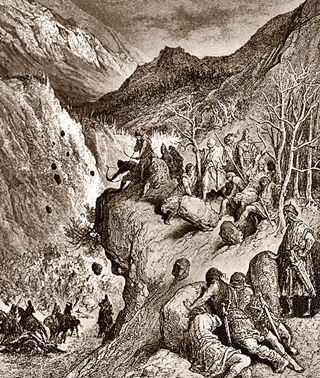
Battle of Myriokephalon(Myriocephalum) |
year: 117617 September 1176 |
| A disastrous Byzantine defeat | ★ ★ ★ ★ ★ |
|
enemy: Seljuk Turks
|
location: Near Lake Beysehir, Turkey (in the mountains of ancient Pisidia)
|
accuracy:
●●●●●
|
|
battle type: Ambush |
war: Seljuk Wars |
modern country:
Turkey |
| ▼ The Byzantines(emperor: Manuel I Komnenos) | ▼ The Enemies | |
| Commander: | Emperor Manuel I Komnenos | Sultan Kilij Arslan II |
| Forces: | 25,000 to 35,000 | Unknown |
| Losses: | Possibly heavy | Heavy |
| Background story: |
| Emperor Manuel I Komnenos decided that it was time to deal with the Turks once and for all, he assembled the full imperial army, and marched toward Iconium the Seljuk capital. The Turks destroyed crops and poisoned water supplies, to make Manuel's march more difficult and harassed the Byzantine army in order to force it into the Meander valley, and specifically the mountain pass of Myriokephalon (exact location unclear, somewhere near lake Beysehir). |
The Battle: |
 “Surprised by the Turks” by Gustave Doré Manuel made some serious tactical errors, such as failing to properly scout out the route ahead and moving his army in a column 10 miles long. These failings caused him to lead his forces straight into a classic ambush. His army was ambushed while marching through the narrow mountain pass. The Byzantines were too dispersed, and were surrounded. The suffered heavy casualties and their siege equipment was destroyed. Manuel lost his nerve both during and after the battle and, moreover, without siege engines, he abandoned his plans to attack Iconium and he was forced to sign a treaty with the Seljuk sultan Kilij Arslan II. |
Noteworthy: |
| The most serious consequence of the defeat was that it dramatically degraded the prestige of Manuel personally, but also of the Byzantine throne in general. The defeat, although not a great disaster, symbolizes the beginning of the end for Byzantium, which since then had virtually ceased to be a superpower. |
Aftermath: |
| The defeat was an embarrassment for Manuel and for Byzantium. It has often been depicted as a cataclysmic catastrophe. Manuel himself compared it to Manzikert; In reality, it was not too costly, and did not ruin the Byzantine army. |
|
|
